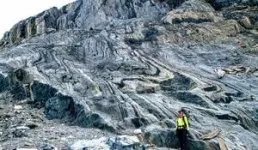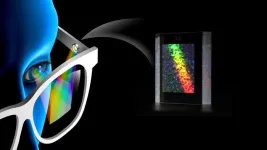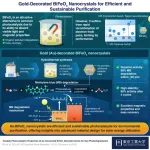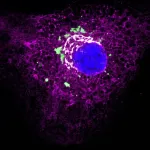(Press-News.org) Estuaries — where freshwater rivers meet the salty sea — are great locations for birdwatching and kayaking. In these areas, waters containing different salt concentrations mix and may be sources of sustainable, “blue” osmotic energy. Researchers in ACS Energy Letters report creating a semipermeable membrane that harvests osmotic energy from salt gradients and converts it to electricity. The new design had an output power density more than two times higher than commercial membranes in lab demonstrations.
Osmotic energy can be generated anywhere salt gradients are found, but the available technologies to capture this renewable energy have room for improvement. One method uses an array of reverse electrodialysis (RED) membranes that act as a sort of “salt battery,” generating electricity from pressure differences caused by the salt gradient. To even out that gradient, positively charged ions from seawater, such as sodium, flow through the system to the freshwater, increasing the pressure on the membrane. To further increase its harvesting power, the membrane also needs to keep a low internal electrical resistance by allowing electrons to easily flow in the opposite direction of the ions. Previous research suggests that improving both the flow of ions across the RED membrane and the efficiency of electron transport would likely increase the amount of electricity captured from osmotic energy. So, Dongdong Ye, Xingzhen Qin and colleagues designed a semipermeable membrane from environmentally friendly materials that would theoretically minimize internal resistance and maximize output power.
The researchers’ RED membrane prototype contained separate (i.e., decoupled) channels for ion transport and electron transport. They created this by sandwiching a negatively charged cellulose hydrogel (for ion transport) between layers of an organic, electrically conductive polymer called polyaniline (for electron transport). Initial tests confirmed their theory that decoupled transport channels resulted in higher ion conductivity and lower resistivity compared to homogenous membranes made from the same materials. In a water tank that simulated an estuary environment, their prototype achieved an output power density 2.34 times higher than a commercial RED membrane and maintained performance during 16 days of non-stop operation, demonstrating its long-term, stable performance underwater. In a final test, the team created a salt battery array from 20 of their RED membranes and generated enough electricity to individually power a calculator, LED light and stopwatch.
Ye, Qin and their team members say their findings expand the range of ecological materials that could be used to make RED membranes and improve osmotic energy-harvesting performance, making these systems more feasible for real-world use.
The authors acknowledge funding from the National Natural Science Foundation of China.
The paper’s abstract will be available on April 24 at 8 a.m. Eastern time here: https://doi.org/10.1021/acsenergylett.4c00320
###
The American Chemical Society (ACS) is a nonprofit organization chartered by the U.S. Congress. ACS’ mission is to advance the broader chemistry enterprise and its practitioners for the benefit of Earth and all its people. The Society is a global leader in promoting excellence in science education and providing access to chemistry-related information and research through its multiple research solutions, peer-reviewed journals, scientific conferences, eBooks and weekly news periodical Chemical & Engineering News. ACS journals are among the most cited, most trusted and most read within the scientific literature; however, ACS itself does not conduct chemical research. As a leader in scientific information solutions, its CAS division partners with global innovators to accelerate breakthroughs by curating, connecting and analyzing the world’s scientific knowledge. ACS’ main offices are in Washington, D.C., and Columbus, Ohio.
To automatically receive news releases from the American Chemical Society, contact newsroom@acs.org.
Note: ACS does not conduct research, but publishes and publicizes peer-reviewed scientific studies.
Follow us: X, formerly Twitter | Facebook | LinkedIn | Instagram
END
In February, OpenAI released videos created by its generative artificial intelligence program Sora. The strikingly realistic content, produced via simple text prompts, is the latest breakthrough for companies demonstrating the capabilities of AI technology. It also raised concerns about generative AI’s potential to enable the creation of misleading and deceiving content on a massive scale. According to new research from Drexel University, current methods for detecting manipulated digital media will not be effective against AI-generated video; but a machine-learning approach could be the key to unmasking these synthetic creations.
In a paper accepted ...
PULLMAN, Wash. – Political conservatives who watched a documentary on Syrian refugees with a virtual reality headset had far more sympathy for the people depicted in the film than those who viewed the same film on a two-dimensional computer screen.
Higher sympathy levels among the conservatives who watched the VR version of the documentary, “Clouds over Sidra,” resulted in a greater willingness to donate to the crisis, according to a study on the research published in New Media & Society.
Liberal participants in the study reported high levels of sympathy and ...
Setting the stage for a new era of immersive displays, researchers are one step closer to mixing the real and virtual worlds in an ordinary pair of eyeglasses using high-definition 3D holographic images, according to a study led by Princeton University researchers.
Holographic images have real depth because they are three dimensional, whereas monitors merely simulate depth on a 2D screen. Because we see in three dimensions, holographic images could be integrated seamlessly into our normal view of the everyday world.
The result is a virtual and augmented reality display that has the potential to be truly immersive, the kind where you can move your head ...
The need for sustainable and environment-friendly solutions has accelerated the global demand for green and renewable technologies. In this regard, semiconductor photocatalysts have emerged as an attractive solution, owing to their potential in mitigating pollutants and harnessing solar energy efficiently. Photocatalysts are materials that initiate chemical reactions when exposed to light. Despite their progress, commonly used photocatalysts suffer from reduced photocatalytic activity and a narrow operation range within the visible ...
Researchers at the Centre for Genomic Regulation in Barcelona and the University of Cologne in Germany have developed a new experimental strategy to tackle scarring and fibrosis. Experiments with patient-derived human cells and animal models showed the strategy was effective, non-toxic and its effects reversible. The findings are published today in the journal Nature Communications.
Scarring occurs from the secretion and accumulation of various components – primarily proteins known as collagens – into the space between individual cells, usually occurring as a response to injury or damage. Excessive collagen secretion can also cause the buildup of fibrotic ...
A new collaboration brings together a world-leading interdisciplinary team with skills across quantum computing, genomics, and advanced algorithms. They aim to tackle one of the most challenging computational problems in genomic science: building, augmenting and analysing pangenomic datasets for large population samples. Their project sits at frontiers of research in both biomedical science and quantum computing.
The project, which involves researchers based at the University of Cambridge, the Wellcome Sanger Institute and EMBL’s European ...
When pathogens invade the body, the immune system must react immediately to prevent or contain an infection. But how do our defence cells stay ready when no attacker is in sight? Scientists from Vienna have found a surprising explanation: They are constantly stimulated by healthy tissue. This keeps them active and ready to respond to pathogens. Based on this insight, future medications could be devised to selectively enhance our immune system’s attention. The study has been published in the journal Nature Immunology (DOI: 10.1038/s41590-024-01804-1).
Communication is crucial in immune defence. When ...
“Our new study shows that renewable-scarce countries like parts of the EU, Japan and South Korea could save between 18 to 38 percent in production costs”, explains Philipp Verpoort, scientist at the Potsdam Institute for Climate Impact Research (PIK) and lead author of the study published in Nature Energy. “They could do so by relocating their production of industrial basic materials like green steel and chemicals based on green hydrogen to countries where renewable energy is cheap.” The use of renewable electricity and green hydrogen is ...
HOUSTON – (April 24, 2024) – Researchers at Texas Children’s Cancer Center and the Center for Cell and Gene Therapy at Baylor College of Medicine, Texas Children’s Hospital and Houston Methodist published results of a phase I clinical trial of a novel immunotherapy for high-risk sarcomas in the journal Nature Cancer.
The therapy uses chimeric antigen receptor (CAR) T cells engineered to target the HER2 protein, which is overexpressed on the surface of sarcoma cells. The HEROS 2.0 trial showed that this therapeutic approach is safe and is associated with clinical benefit.
“CAR T cell therapy has been a highly successful strategy for recurrent ...
The emergence in the Neolithic of patrilineal1 social systems, in which children are affiliated with their father's lineage, may explain a spectacular decline in the genetic diversity of the Y chromosome2 observed worldwide between 3,000 and 5,000 years ago. In a study to be published on 24 April in Nature Communications, a team of scientists from the CNRS, MNHN and Université Paris Cité3 suggest that these patrilineal organisations had a greater impact on the Y chromosome than mortality during conflict.
This ...







